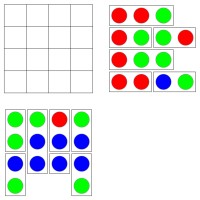Part of the fun of writing a math blog is designing new puzzles. I wanted to come up with a puzzle which incorporated color and logic, so here’s the result!
In the grid below, slide the tiles either horizontally or vertically onto the grid so that each row and column contains exactly one each of green, cyan, magenta, and yellow dots. When two dots share the same square, they are combined, so that if a green and a red dot occupy the same square, the dot is yellow, while if a blue and a green dot occupy the same square, a cyan dot is produced. In other words, overlapping the tiles is like adding their RGB values. (If you aren’t familiar with RGB values, you can experiment in the “Continue reading” section by searching for Day002 in my blog.) Horizontal tiles may only overlap vertical tiles (and not other horizontal tiles), and vertical tiles may only overlap horizontal tiles.
Dots of the same color may never overlap — although this condition follows from the puzzle setup. Note that green, cyan, and yellow all require a green dot, so with four rows/columns, at least 12 green dots are necessary. Since there are exactly 12 green dots, no two green dots may overlap. Similar arguments show that no two red dots or two blue dots may overlap, either.
In the first part of the post, we’ll solve this puzzle so you see what’s involved. We’ll look at the design later.
Let’s start by looking at Column 1. Each row column needs three green dots, two red dots, and two blue dots — this follows from the fact the the RGB values of the four colors in the completed puzzle are (0,1,0), (0,1,1), (1,0,1), and (1,1,0). Since the vertical tiles in Column 1 already include three green dots, we know how to place the tiles in Row 2, since we need to avoid a fourth green dot in the first column. This results in
Now see that however the tiles are placed in Column 1, the dot at (2,1) — Row 2 and Column 1 — must be yellow. So (2,4) can’t be yellow, and therefore we know how to place the tiles in Column 4.
Note how the red and blue dots overlap to create magenta. Since there are no blue dots in the completed puzzle, we must place the tile in Row 3 so that the blue dot is covered by a green one (making a cyan dot).
Since green dots cannot overlap, we know how to place the tiles in Rows 1 and 4. Note the red and green dots overlapping in (4,4) to create yellow.
Since green dots cannot overlap, we know how to place the tile in Column 2. See how the overlapping dots create yellow, cyan, and magenta dots.
Now in Column 1, there can only one be yellow dot. So we know how to place the tiles in Column 1, and it is easy to slide the remaining tiles from Column 3.
That wasn’t so bad! Just a little knowledge of color theory and a bit of logic is all you need.
These puzzles are fun to create. However, there are a few issues to be aware of. The first arises since you want to avoid too many single dots — I used just one in the first puzzle, and I think that’s enough. It’s actually rather easy to create a grid with one of each color in each row and column — there are called Latin squares. The hard part is then creating an appropriate set of tiles. The difficulty lies with the fact that some squares are covered by just one tile, others by two.
In the following small grid, the numbers represent how many dots are needed to create a color in a certain location.
Suppose we wanted a vertical tile to cover a 1 and a 2 in column 3. Since (2,3) is covered by two tiles and vertical tiles cannot overlap, this means we must use a horizontal tile here. But then the only way to cover location (1,2) is with a horizontal tile and a vertical tile of height 1 (since the 1’s are already covered). But this is exactly what we want to avoid! Once I realized was happening, I first designed a grid with just 1’s and 2’s and a corresponding tile set, then added the colors later. In other words, I broke a harder design problem into two easier ones.
The other issue which arose was the question of uniqueness. It’s desirable to have a unique solution to puzzles like this — when you design a puzzle, you clearly have one solution, but can you be sure that there aren’t any others? This is not an insurmountable task, but for the larger puzzle below, it was more involved than I thought it would be.
So I leave you with a 6 x 6 puzzle to solve. Slide the tiles so that there is a red, green, blue, yellow, magenta, and cyan dot in each row and column. As mentioned above, the solution is unique. Feel free to post your own puzzles if you create them!


















